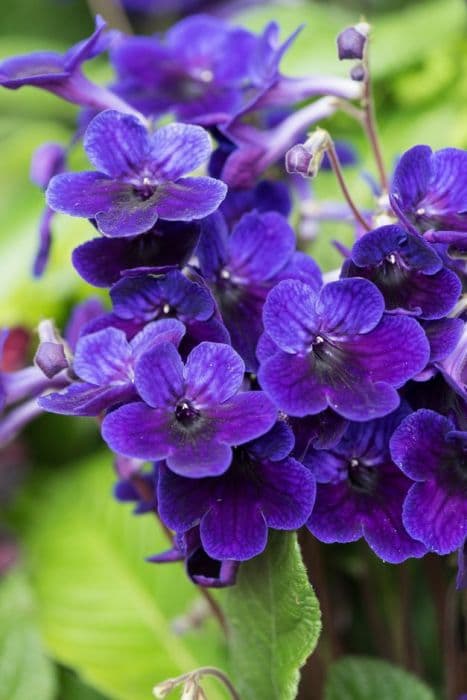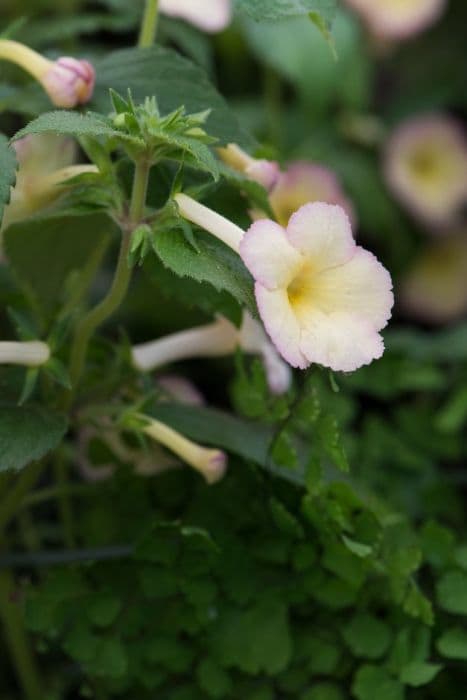Cape Primrose Streptocarpus 'Stella' Fleischle (Marleen Series)

ABOUT
Streptocarpus 'Stella' Fleischle, which comes from the Marleen Series, is a captivating houseplant known for its ornamental value and charming blooms. The plant exhibits a rosette-like growth form, composed of lush, velvety, dark green leaves that often show a slight ruffle or wave along their edges. These leaves provide a rich, textured backdrop for the standout feature of the plant—its flowers. The blooms of Streptocarpus 'Stella' Fleischle are truly the star attraction. Emerging on slender, arching stems, the flowers are trumpet-shaped, exuding a sense of delicate elegance. Commonly, the flowers flaunt a vivid shade of purple with intricate patterns, including streaks or spots that might be a paler hue or a dramatic, contrasting white throat. The petals may occasionally show gentle fluting or ruffled edges, adding to their overall allure. Bearing flowers intermittently throughout the year, this variety ensures a continuous display of color and vibrancy indoors. It is often favored for its prolonged blooming period, which can grace an indoor setting with its charm for several months at a time. Additionally, the Streptocarpus 'Stella' Fleischle is valued for its compact and tidy nature, which makes it an excellent choice for those who appreciate plants that don't take up too much space and allow for a clutter-free aesthetic. Overall, its appealing foliage combined with its striking, long-lasting flowers, makes it a popular choice for plant enthusiasts who enjoy its exquisite display.
About this plant
 Names
NamesFamily
Gesneriaceae.
Synonyms
Cape Primrose, False African Violet, Twisted Fruit.
Common names
Streptocarpus 'Stella' Fleischle
 Toxicity
ToxicityTo humans
The Streptocarpus, commonly known as Cape Primrose, is generally not considered toxic to humans. However, it's always a good practice to avoid ingesting plants that are not known to be edible, as they could potentially cause mild stomach upset or an allergic reaction in sensitive individuals. There are no widespread reports of serious poisoning or life-threatening consequences associated with the ingestion of Cape Primrose.
To pets
Cape Primrose (Streptocarpus) is also not known to be toxic to pets. It is not listed among the common toxic plants that pose a risk to dogs and cats. Although it is not considered poisonous, if a pet ingests a large amount of the plant, it might experience mild gastrointestinal upset, such as vomiting or diarrhea, simply due to the ingestion of non-food material. It is always recommended to keep an eye on your pets and to prevent them from chewing on any houseplants.
 Characteristics
CharacteristicsLife cycle
Perennials
Foliage type
Evergreen
Color of leaves
Green
Flower color
Varies
Height
1 foot (30 cm)
Spread
1 foot (30 cm)
Plant type
Herb
Hardiness zones
10
Native area
Africa
Benefits
 General Benefits
General Benefits- Low Maintenance: Streptocarpus, commonly known as Cape Primrose, requires minimal care compared to many other flowering houseplants.
- Long Blooming Season: Cape Primrose often has a lengthy blooming period, providing color and interest in the home for much of the year.
- Variety of Colors: The 'Stella' variety offers a range of flower colors, adding aesthetic variety to indoor spaces.
- Compact Growth: It is well-suited for small spaces due to its compact size, making it ideal for apartments or small windowsills.
- Indoor Decorative Appeal: With its attractive foliage and flowers, Cape Primrose serves as an excellent decorative element in interior design.
- Tolerance of Low Light: This plant can thrive in low light conditions, making it suitable for rooms with less natural sunlight.
- Propagation Ease: Cape Primrose can be easily propagated from leaf cuttings, allowing for the creation of new plants from an existing one.
- Non-Toxic: It is safe for households with pets and children, as it does not contain any known toxic substances.
 Medical Properties
Medical PropertiesThis plant is not used for medical purposes.
 Air-purifying Qualities
Air-purifying QualitiesThis plant is not specifically known for air purifying qualities.
 Other Uses
Other Uses- Artistic and Craft Inspiration: Streptocarpus can be used as a subject in painting, drawing, and photography due to its vibrant flowers and attractive foliage.
- Educational Tool: Streptocarpus plants can be utilized in schools or educational workshops to teach botany, horticulture, and plant biology.
- Botanical Model: These plants can serve as model organisms for botanical studies due to their diverse range of colors and growth habits.
- Biological Indicator: Streptocarpus 'Stella' could be studied for changes in blooming patterns as a potential indicator of climate change effects.
- Scented Garden Addition: While not known for a strong fragrance, some Streptocarpus varieties might contribute to a subtly scented garden experience.
- Photoperiodism Experiments: Hobbyists and researchers can use Streptocarpus to study the effects of light on plant flowering cycles.
- Color Therapy: The calming blue and purple hues of Streptocarpus flowers can be utilized in color therapy to create tranquil environments.
- Dyes and Pigments: The rich colors of the flowers might be used in a natural dye-making process for fabrics or art projects.
- Feng Shui: Streptocarpus can be incorporated into Feng Shui designs to create balance and harmony within the home.
- Collectors' Specimen: Specialty growers may cultivate rare or unusual Streptocarpus cultivars as a hobby, creating a collection of unique specimens.
Interesting Facts
 Feng Shui
Feng ShuiThe Cape Primrose is not used in Feng Shui practice.
 Zodiac Sign Compitability
Zodiac Sign CompitabilityThe Cape Primrose is not used in astrology practice.
 Plant Symbolism
Plant Symbolism- Endurance and Persistence: The Streptocarpus, also known as Cape Primrose, often symbolizes the ability to endure challenging conditions and persist through difficulties, as they can thrive in environments with indirect light and need minimal care.
- Lasting Affection: With its long-lasting flowers, the Cape Primrose is sometimes seen as a symbol of lasting affection and enduring love between the giver and the recipient.
- Adaptability: Reflective of its capacity to adapt to different lighting conditions, Cape Primrose can signify a person's ability to adjust to various situations in life.
- Hope and New Beginnings: As a flowering plant that blooms repeatedly, Cape Primrose may represent hope, renewal, and the start of new beginnings or ventures.
 Water
WaterFor a Cape Primrose, water the plant thoroughly when the top inch of soil feels dry to the touch, which typically means once a week. Use enough water so that it runs out of the drainage holes at the bottom of the pot—this could amount to roughly 8-16 ounces for a small to medium-sized plant. Avoid overwatering as it can lead to root rot; the soil should be moist but not soggy. During the winter months, you may need to water less frequently as the plant's growth slows down. Ensure the pot allows for good drainage to prevent excess water from sitting at the roots.
 Light
LightCape Primrose thrives in bright, indirect light, so place it near a window with a sheer curtain to filter intense sunlight. Direct sun can scorch the leaves, so it's best to avoid placing the plant in a south-facing window without any shade. If the light is too low, the plant may not produce flowers, so if you notice a lack of blooming, consider moving it to a brighter spot.
 Temperature
TemperatureCape Primroses prefer temperatures between 60 and 75 degrees Fahrenheit and can survive a minimum temperature of around 50 degrees Fahrenheit but should not be subjected to temperatures below that, as they are not frost-tolerant. They thrive in typical indoor temperatures but should be kept away from cold drafts and heating vents.
 Pruning
PruningPruning Cape Primroses is important to encourage bushier growth and more blooms. Remove any yellow or dead leaves, and pinch back the growing tips after flowering to promote a denser plant. The best time to prune is immediately after a flush of flowers has faded, typically every few weeks during the blooming season.
 Cleaning
CleaningAs needed
 Soil
SoilCape primrose prefers well-draining soil with a mix of potting soil, perlite, and peat moss, ensuring good aeration. The ideal pH for Cape primrose is slightly acidic to neutral, around pH 5.5 to 6.5.
 Repotting
RepottingCape primrose should be repotted every 1-2 years or when the plant becomes root-bound. Use fresh soil mix when repotting to promote healthy growth.
 Humidity & Misting
Humidity & MistingCape primrose thrives in moderate to high humidity, ideally between 50-60%. Avoid overly dry conditions to maintain plant health.
 Suitable locations
Suitable locationsIndoor
Place Cape primrose in bright, indirect light and keep soil moist.
Outdoor
Grow in shade; shelter from wind and direct sun.
Hardiness zone
10-11 USDA
 Life cycle
Life cycleCape Primrose 'Stella' Fleischle begins its life as a seed which, under the right conditions, will germinate and emerge as seedlings with basal rosettes of leaves. As these rosettes mature, they develop long, thin stems or pedicels that bear the plant’s distinctive, velvety flowers, which can bloom multiple times per year if conditions are favorable. After pollination, the flowers will wilt and the plant will produce seed pods, known as streptocarps, which twist as they mature. These seed pods eventually dry and split open to release seeds, continuing the cycle. Cape Primroses may also be propagated vegetatively through leaf cuttings, where a portion of a leaf is used to grow a new plant. Over time, the plant will grow larger, but it may become leggy and require pruning or rejuvenation to maintain a compact form and encourage healthy growth.
 Propogation
PropogationPropogation time
Spring-Early Summer
Streptocarpus 'Stella', a plant from the Marleen Series, commonly known as Cape Primrose, can be propagated by leaf cuttings, which is the most popular method. The best time to do this is late spring to early summer when the plant is actively growing. To propagate, a healthy leaf is selected and cleanly cut across the width, making multiple sections each with a vein. Each section is then placed vein-side down in a moist potting mix made specifically for African violets or one with similar characteristics. The potting mix should be kept consistently moist but not soggy, and in a warm environment with indirect sunlight. Roots and new plants will usually begin to form at the site of the buried vein within a few weeks to a couple of months. Once the new plants have established their root system, they can be carefully separated and potted individually.









